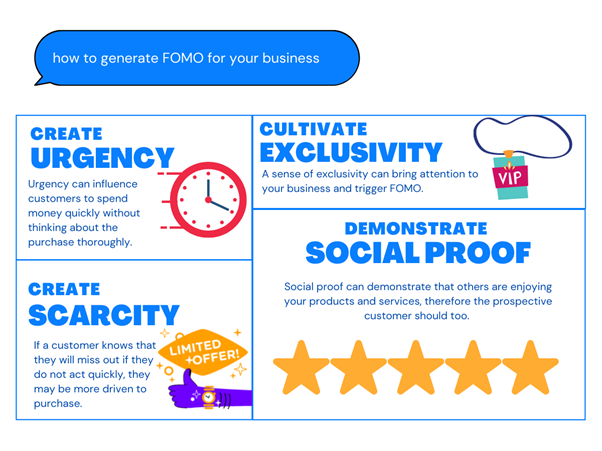How To Generate FOMO For Your Business
June 16, 2023
FOMO, which stands for fear of missing out, refers to a marketing strategy that appeals to consumers’ desire to seize every opportunity before it disappears. As people are naturally risk-averse, they would rather impulse-buy than be left thinking ‘what if?’
Generating FOMO around your business can be broken down into three main components. Firstly, you will want to generate buzz around your business and get consumers interested in your product, which will create brand recognition and show there is a demand for your business. This buzz will then provide evidence of an opportunity, which you will need to highlight to your customers. For example, buzz generated around a particular item of clothing has the opportunity for the purchaser to look stylish. Finally, once you have generated buzz and opportunity, creating scarcity around your products will make customers want to purchase quickly so that they don’t miss out.
Business Foundations has compiled a list of tips to implement FOMO-inducing marketing strategies for your products and services.
1. Create urgency.
Placing a time-based limitation on your products or services can create a sense of urgency, which can influence customers to spend money quickly without thinking about the purchase thoroughly. To achieve this, you may consider running a countdown timer for the end of a sale, sending customers a reminder towards the end of a sale, or having a counter on your website that records the amount of stock left for a particular item. If you do not want to discount your products, a service provider could only open their bookings for a limited time-period.
2. Create scarcity.
Offering limited runs of your products or limited bookings for a service creates scarcity, which brings out FOMO to prompt quick sales. If a consumer knows that they will miss out if they do not act quickly, they may be more driven to purchase. If you generate FOMO well and products are scarce, it can also reduce the likelihood that you will have excess inventory or will need to discount the product later. For example, a clothing brand could run a limited run of a t-shirt design and only make 500 units available.
3. Cultivate exclusivity.
Exclusivity brings attention to your business and increases FOMO. There are many different ways to make your products or services exclusive, including:
- You may only offer discounts to people who have signed up to your mailing list or purchased from you before,
- You could host a product launch event, inviting your best customers and encouraging them to post about the event on social media,
- You could mail free samples of a new product to your best customers,
- You could offer early access to a new product for people on your mailing list.
In using these strategies to cultivate exclusivity, you make the recipients of these offers feel like a valued customer, whilst also triggering FOMO in the people that missed out. This may influence people to sign up to your mailing list for next time.
4. Demonstrate social proof.
Social proof is reviews, testimonials, or user generated content from customers that can appear as a personal recommendation for your business. This can appear to prospective customers that other people are enjoying your products, and therefore they should have the products too. Your business should consider promoting some of your best reviews and case studies. In addition, you could run a campaign where customers who post a picture to social media using your product can receive a discount.

Generating FOMO can be a great marketing strategy to drive more sales for your business. In creating buzz, opportunity, and scarcity, you can create a community of customers that will be eagerly awaiting to purchase.
Acknowledgement Of Country
Business Foundations acknowledges the traditional custodians throughout Western Australia and their continuing connection to the land, waters and community. We pay our respects to all members of the Aboriginal communities and their cultures; and to Elders both past and present.
Victoria
The Commons
80 Market Street,
South Melbourne VIC 3205
admin@businessfoundations.com.au
Western Australia
Wesley Central
2 Cantonment Street,
Fremantle WA 6160
admin@businessfoundations.com.au


Get In Touch
Have a question or to find out how we can help you, please get in touch.






